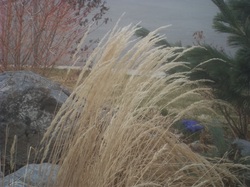
Fertilizing right makes a huge difference in how quickly your trees grow, and how healthy they are.
Pruning also helps their health; you cut out anything broken or diseased, remove branches that rub (these would open them to more disease and breakage), helps make for strong trees (by selecting and balancing good branches with strong angles), and opens the tree up to allow more light onto the leaves and fruit/flowers, making it more productive. Some shrubs give more blossoms and better stem color (like the red-twig dogwood, above) when pruned.
Most trees handle pruning best while dormant, so right now is perfect. Fertilizing fruit trees and other fruit-bearing shrubs is best done before you see the flowers. You can still do it after, but the resulting fruit will be softer and bruise more easily. Now is a great time for this, too.
These great videos and links are from the USU Extension site. Right now is a perfect time to prune. So if you have been wondering how to really prune a fruit tree, this video's for you!
§ Step By Step Orchard Pruning (video) - techniques demonstrated by Matt Palmer
Here is info on pruning other things:
§ Pruning Landscape Trees
§ 5 Minute Pruning Shrubs (video)
How to Prune A Rose Bush (video)
If you don't know how to choose a fertilizer, see Selecting and Using Inorganic Fertilizers
To fertilize a fruit tree the simplest way, measure the width (diameter) of the trunk. You need 2-4 ounces of actual nitrogen per inch of diameter. If you have a new tree, 1" diameter trunk, let's say you'll need 2 ounces. If you have a bag of fertilizer that says 33-0-0, that means it is 33% nitrogen by weight. To get 2 ounces of nitrogen, you'll need 6 ounces of this particular fertilizer . If you have a bag of 10-10-10, you'll need 20 ounces of that one. (see the fertilizer link above.) If you already know this and want to know more, there are more details here, Fertilizing Fruit Trees.
--Rhonda
http://www.theprovidenthomemaker.com
 RSS Feed
RSS Feed